Personality is a key concept in the study of Behaviour, offering insight into the unique patterns of thoughts, emotions, and actions that define individuals. This topic explores various theories of personality, including the Type and Trait approaches, while also examining the determinants of personality. Methods of assessment such as self-report measures, projective techniques, and behavioural analysis help researchers and psychologists understand personality in depth.
Previous year Questions
| Year | Question | Marks |
| 2024 | What are major Issues in personality assessment? | 5 M |
| 2023 | Explain type A and type B personality as suggested by Friedman & Rosenman. | 5 M |
| 2021 | Which are the big five factors of personality? | 2 M |
| 2021 | Describe the major projective measures of personality. | 5 M |
| 2018 | What is an idiographic approach to personality ? | 2 M |
| 2018 | What is Thema and Apperception in TAT ? | 2 M |
| 2016 | What do you understand about “Eros” and “Thanatos” ? | 2 M |
| 2016 | Explain Introvert and Extrovert Personality. | 2 M |
| 2016 | Explain the characteristics of Projective Technique of Personality Assessment. | 5 M |
| 2016 special | Describe Allport’s definition of Personality. | 2 M |
| 2016 special | How are Semi projective techniques useful to assess personality ? | 5 M |

The literal meaning of personality is derived from the Latin word persona, persona refers to the mask which is used in plays. Personality includes both physical and psychological (calmness, solemn nature, shyness, cheerfulness, intelligence) attributes of a person. These attributes are relatively stable and do not change with time.
Psychologically, personality is our unique ways of behaving in different situations such as, excited, joyful, warm, or friendly, etc.
Conclusively personality is characterised by the following features:
- It has both physical and psychological components.
- Its expression in terms of behaviour is fairly unique in a given individual.
- Its main features do not easily change with time.
- It is dynamic in the sense that some of its features may change due to internal or external situational demands.
Thus, personality is adaptive to situations.
Definitions of Personality
Ncert- “Personality refers to unique and relatively stable qualities that characterise an individual’s behaviour across different situations over a period of time.”
Gordon Allport – “The dynamic organization within the individual of those psychophysical systems that determine his unique adjustments to the environment.”
Raymond Cattell – “Personality is that which permits a prediction of what a person will do in a given situation.”
Eysenck – “Personality can be defined as a more or less stable and enduring organisation of a person’s character (cognitive behaviour system), temperament (affective behaviour system), intellect (cognitive behaviour system), and physique (bodily configuration and neuroendocrine endowment), which determines their unique adjustment to the environment.”
Theories of personality
There are many ways in which psychologists have explained personality. These theories suggest ways of assessment of the structure of personality, motivation or energy sources, and the study of development of differences in personality. Generally these theories are classified into five types namely, Type, Trait, psychoanalytic, humanistic, learning and socio-cognitive theories.
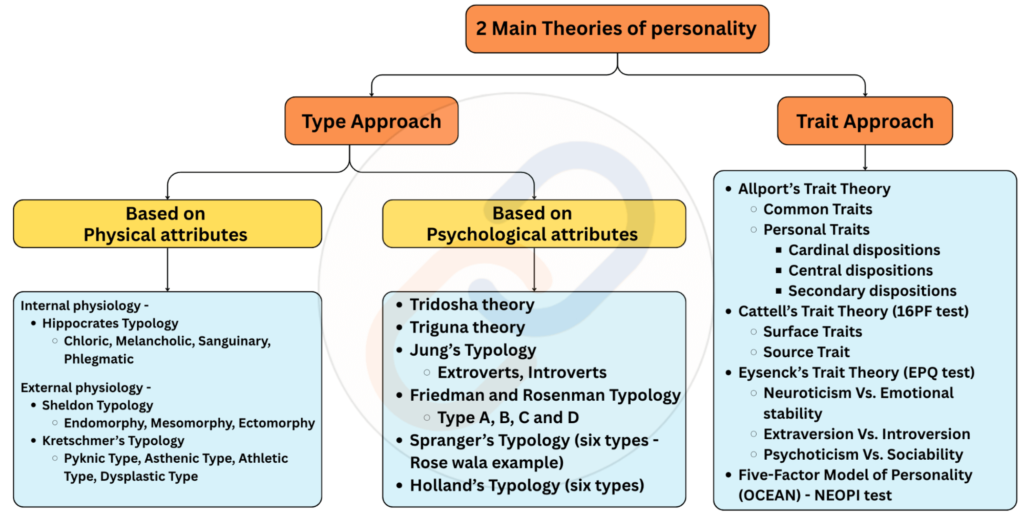
Type Approach
According to Morgan and King, “ A type is simply a class of individuals said to share a common collection of characteristics.” For example, some people prominently show tendencies of being outgoing, happy-go-lucky nature, mixing with people, less task orientation etc. These people are classified as extroverts. A number of thinkers have given their typological models to explain personality, some of which include.
Tridosha theory :
Charak Samhita classifies people into the categories of vata, pitta and kapha on the basis of three humoural elements called tridosha. Each refers to a type of temperament, called prakriti (basic nature) of a person. Following are the attributes of these personalities-

Triguna theory :
- It classified personality into 3 types Sattva, Rajas, Tamas. The attributes of these personalities are
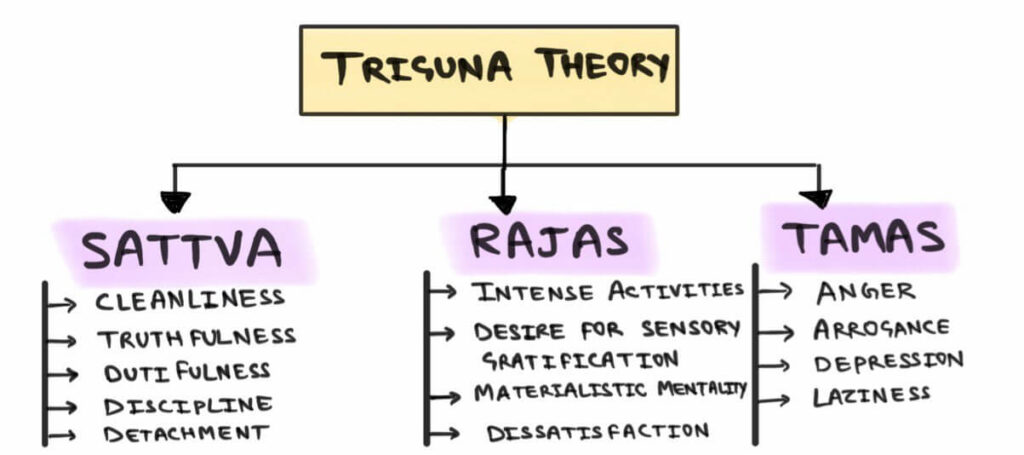
Hippocrates Typology :
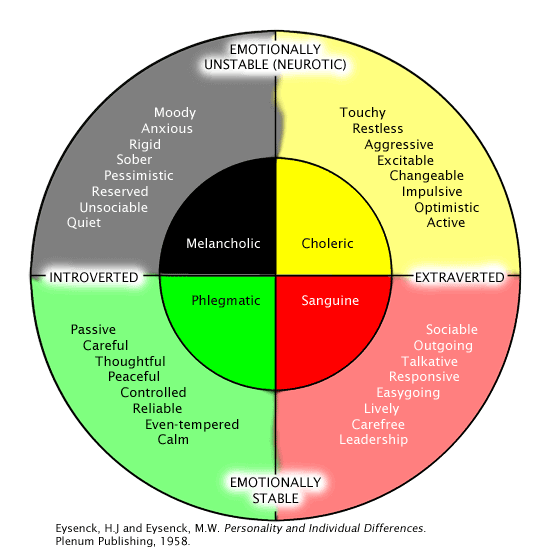
In 400 B.C. Hippocrates attempted to explain personality in terms of body fluid or humours. He postulated that our body has four types of fluid; yellow bile, black bile, blood and phlegm. Every person is characterised by the prominence of one type of fluid which determines the temperament of the person concerned. Thus he classified people into four types which are given below:
- Choleric – people with predominance of yellow bile are irritable, restless and hot blooded.
- Melancholic – people with high black bile are sad, depressed and devoid of hope in life
- Sanguinary – When blood content is high the person remains cheerful, active and he is optimistic in life.
- Phlegmatic – predominance of phlegm makes a person calm and quite and us
Sheldon’s Typology :
Sheldon on the basis of physical constitution categorised personality into somatotypes. For this he analysed nude photographs of 4000 students and classified their personalities into three basic types.
- Endomorphy – Such persons are short and fatty with a round shape of body. They like to eat and drink and make merry. They are gregarious by nature and have a leisurely attitude toward life. e Sheldon termed them “viscerotonia.”
- Mesomorphy – These people are muscular types. Their muscles and bones are quite well developed and they are physically well shaped. These people generally are considered to be tough-minded, risk taking, assertive and aggressive. They like to boss over others. Sheldon called these personalities as “somatotonia”
- Assertive, Energetic, Physically active
- Ectomorphy – Such people are tall but thin. These people like to remain away from people. Sheldon called them “cerebrotonia”.
- Introvert, Private, Shy, Sensitive
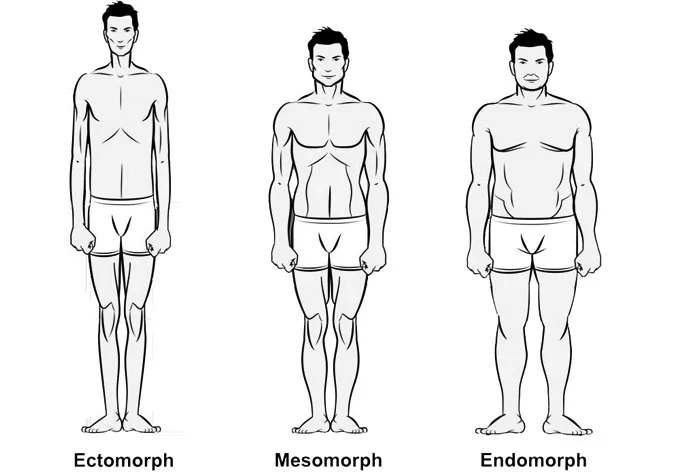
Jung’s Typology :
Jung postulated personality theory based on psychological characteristics. He divided people into two broad types i.e. extroverts and introverts.
- Extroverts – Such people are socially oriented. They like to mix up with people, are fun loving, optimistic. They are realistic in their approach towards life. Often such people exhibit leadership qualities.
- Introverts – They are the opposite of extroverts. They do not like to mingle with people. They have very few friends. They are self-centered and conservative. Such people are dogmatic in the sense that they follow the traditions and customs of the society without ever giving thought to their justifiability.
Criticism : Jung’s classification has been criticised on the ground that it is not possible to divide people into two watertight compartments because a significant number of people do not fall in either of the categories. They exhibit characteristics of both the extrovert and introvert type. To compensate for this psychologists placed such persons into another category called ambiverts.
Friedman and Rosenman Typology :
They initially classified personality into 2 types (Type A, Type B) which was expanded to include Type C and Type D. It is based on Behaviour, Attitude, and responses to stress.
- Type A: Personality seems to possess high motivation, lack patience, feel short of time, be in a great hurry, and feel like being always burdened with work. Such people find it difficult to slow down and relax.
- Susceptibility to disease: hypertension and coronary heart disease (CHD)
- Type B : Type B personalities are known for their relaxed, patient, and easygoing nature. They remain Less motivated, lazy and dull.
| Type A | Type B |
| Highly competitive | Less competitive |
| In hurry | Relatively relaxed |
| Highly ambitious | Less ambitious |
| Like to be in controlling position | Does not enjoy control |
| Stressed | Less stresses |
- Type C : Individuals characterised by this personality are cooperative, unassertive and patient. They suppress their negative emotions (e.g., anger), and show compliance to authority.
- Problem: Prone to cancer
- Type D : This type has developed recently. personality has been suggested, which is characterized by proneness to depression.
Spranger’s Typology :
Spranger in his book “Types Of Man” described six types of man, taking into account their value orientation in life.
- Theoretical Type ; – They are seekers of truth. They try to understand and make sense of the world around them through reason and logic. For example, if a Rose is given to them, they will think of questions like, “Is it really a rose?” and “What are the characteristics of a rose?”
- Economic Type ;– They are basically utilitarian. They view things from the point of view of practicality and their economic value. For eg;- If a Rose is given to them then they will think of how to make profit out of it.
- Aesthetic Type;- These people are lovers of nature and beauty. They lay emphasis on form and harmony and believe in making life attractive and charming. For eg;- If a Rose is given to them, they’ll praise it’s beauty and preserve it.
- Social type ;- Such people are gregarious, like to mingle with people in social gatherings. They often enjoy good prestige in society.for eg;- They may greet a friend’s birthday by presenting him Rose.
- Political Type – These are people who value power and influence. Their behaviour is oriented toward gaining power and influence over others. For example, a person of this type may make a garland of roses and garland the powerful politician to win his favour
- Religious Type – This type of person lays emphasis on the unity of the cosmos. They have a spiritual bent of mind and believe in God. such a person may lay the rose on the feet of God.
Holland’s Typology :
Holland’s is the latest type theory put forth for the explanation of personality. According to him, personality is a combination of interests, values and competencies. He classified people into six types:
- Realistic Type :- These are practical people who do highly skilled work, operate machinery and many complex instruments. For eg;- Engineers, technicians
- Investigative Type :- These are highly creative and innovative persons who gather data, analyse and interpret them with a view to solve problems. For eg;-scientists, researchers
- Artistic Type :- Such persons are actually artists, painters, designers and so on. They are skilled in designing, creating new and innovative structures.
- Social Type :- Such persons are compassionate in their approach, they like to work for others and bring relief to people in distress. For eg;- social workers
- Enterprising Type :- They are the ones who take risks and are ready to take a challenge. For eg;- Entrepreneurs
- Conventional Type :- These are people who are traditional in their approach. They go by rules and regulations and will expect others also to follow the same.
Kretschmer’s Typology :
He was a German psychiatrist who on the basis of his observation of patients classified people into four types. He used the physical constitution and temperament for this purpose.
- Dysplastic Type :- This category includes people who do not exhibit any of the characteristics mentioned above but are a mix of all three types.
- Pyknic Type :- Such people are short in height with a heavily built body, social and cheerful, and like to eat and sleep. Kretschmer called them “cycloids” as they have a high probability of falling prey to manic-depressive types of psychopathology.
- Asthenic Type :- Such persons are tall and thin with underdeveloped muscles. They are irritable and shirk away from responsibility. They have the habit of daydreaming and are lost in the world of fantasy.
- Athletic Type : – These are muscular types and have well built muscles and are neither tall nor short. They have a stable and calm nature and are able to adjust themselves to changes in the environment.
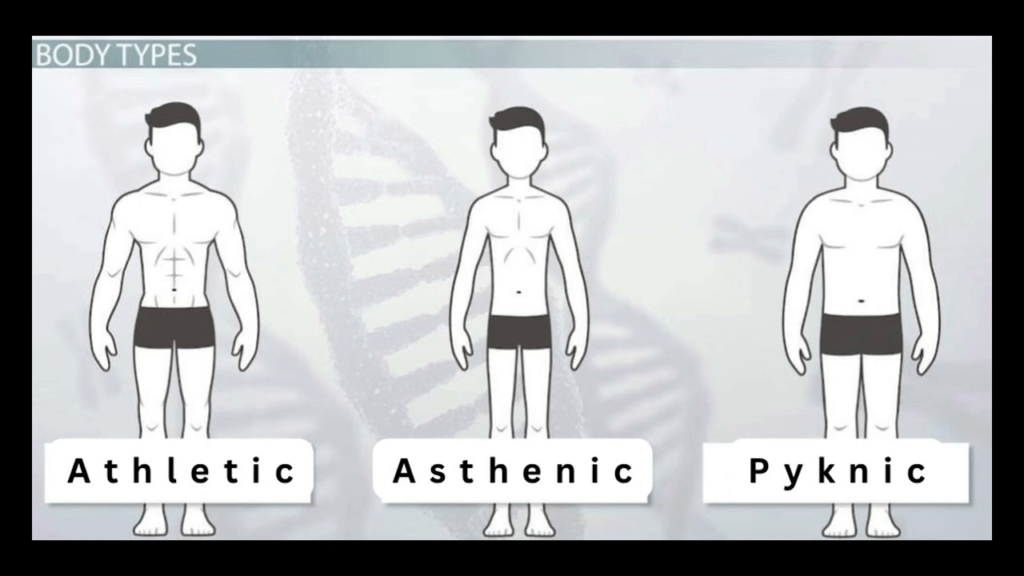
Trait Approach
According to Atkinson, Atkinson and Hilgard “A trait refers to any characteristic that differs from person to person in a relatively permanent and consistent way.” Trait approach got maximum impetus from the work of Allport, Cattlell and Eysenck.
Allport’s Trait Theory :
Allport mentioned two types of traits ; common and personal traits.
- Common Traits – These traits are found in the majority of persons living in a society or culture. For eg If X shows a trait of cooperativeness in his behaviours in various situations, and if similar behaviours are obtained in a large number of persons from that community or culture, this trait will be considered common Trait.
- Personal Traits – This refers to the unique characteristics of a person and not shared by other members of the society or community or culture. These traits are highly consistent and can be seen in almost all behaviors of this individual irrespective of the situation concerned. For eg, the trait of parsimony, is something which an individual will show in almost every aspect of his behaviour whether he is at home or office or school or anywhere. It is further divided into three subcategories.
- Cardinal dispositions: such traits have an overriding and overwhelming influence on the behaviour of a person. For eg. Gandhi advocated for peace and Non-violence which can be explicitly seen in whatever Mahatma Gandhi did in his life.
- Central dispositions: These traits actually define the personality of a person. For eg. a person who has the traits of honesty, punctuality, parsimony, cleanliness and generosity, will always be on time to the office, and keep the scheduled meetings on time and never will waste anyone’s time, will always be straight forward.
- Secondary dispositions: These traits of a person are less consistent, less explicit and less meaningful for the person and hence are called secondary traits. For eg, hair style, dressing sense etc.
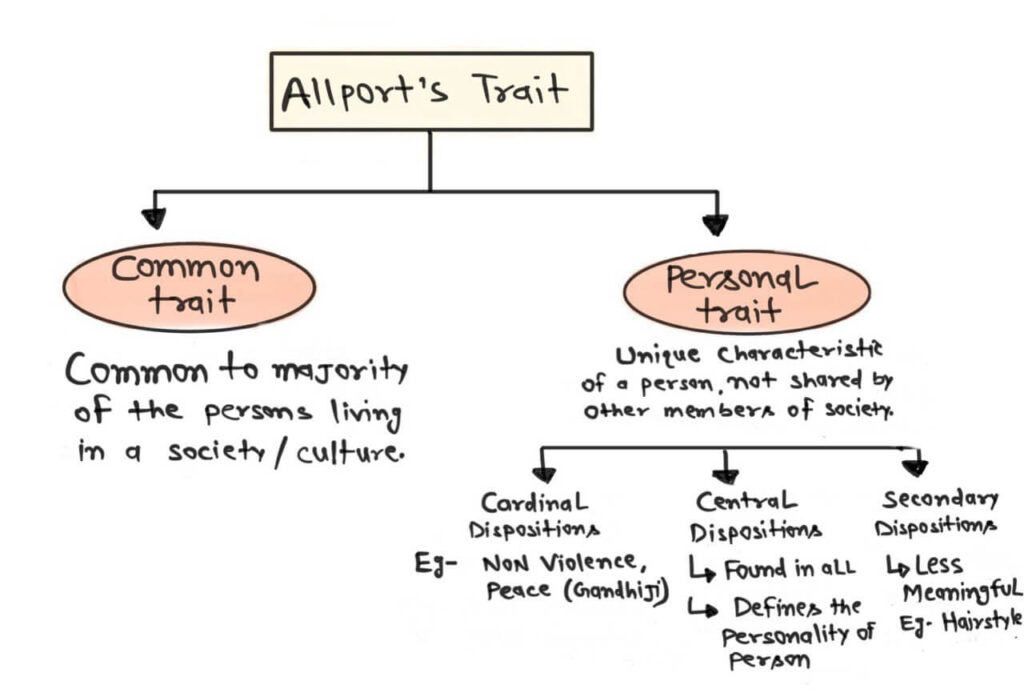
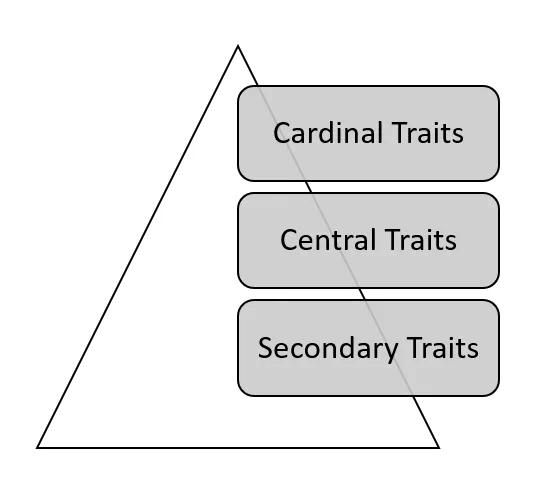
Cattell’s Trait Theory:
R.B. Cattell divided traits into two categories, viz., surface traits, and source traits.
- Surface Traits – As the name suggests these are found on the periphery of personality i.e. these are reflected in the day to day interactions of the person.
- Source Trait – These traits are not observable in day to day interactions of the person. Source traits come to notice when some of the surface traits are joined together. For example, sociability, unselfishness and humor are surface traits which when joined together create a source trait known as friendliness. Cattell mentioned two types of source traits
- environmental mould traits
- constitutional traits.
He found 16 primary or source traits and developed a test, called Sixteen Personality Factor Questionnaire (16PF), for the assessment of personality.
Eysenck’s Trait Theory :
H.J. Eysenck proposed that personality could be reduced into two broad dimensions. These are biologically and genetically based. Each dimension subsumes a number of specific traits. These dimensions are:
- Neuroticism Vs. Emotional stability : It refers to the degree to which people have control over their feelings. At one extreme of the dimension, we find people who are neurotic. They are anxious, moody, touchy, restless and quickly lose control. At the other extreme lie people who are calm, even-tempered, reliable and remain under control.
- Extraversion Vs. Introversion : It refers to the degree to which people are socially outgoing or socially withdrawn. At one extreme are those who are active, gregarious, impulsive and thrill-seeking. At the other extreme are people who are passive, quiet, cautious and reserved.
- Psychoticism Vs. Sociability : In a later work Eysenck proposed a third dimension, called Psychoticism vs.Sociability, A person who scores high on the psychoticism dimension tends to be hostile, egocentric, and antisocial.
Eysenck Personality Questionnaire is the test which is used for studying these dimensions of personality.
Five-Factor Model of Personality:
Psychologists Robert McRae and Paul Costa distilled Cattell’s personality theory down to five personality traits that “define human personality. They are often called Big Five Factors. These factors include:
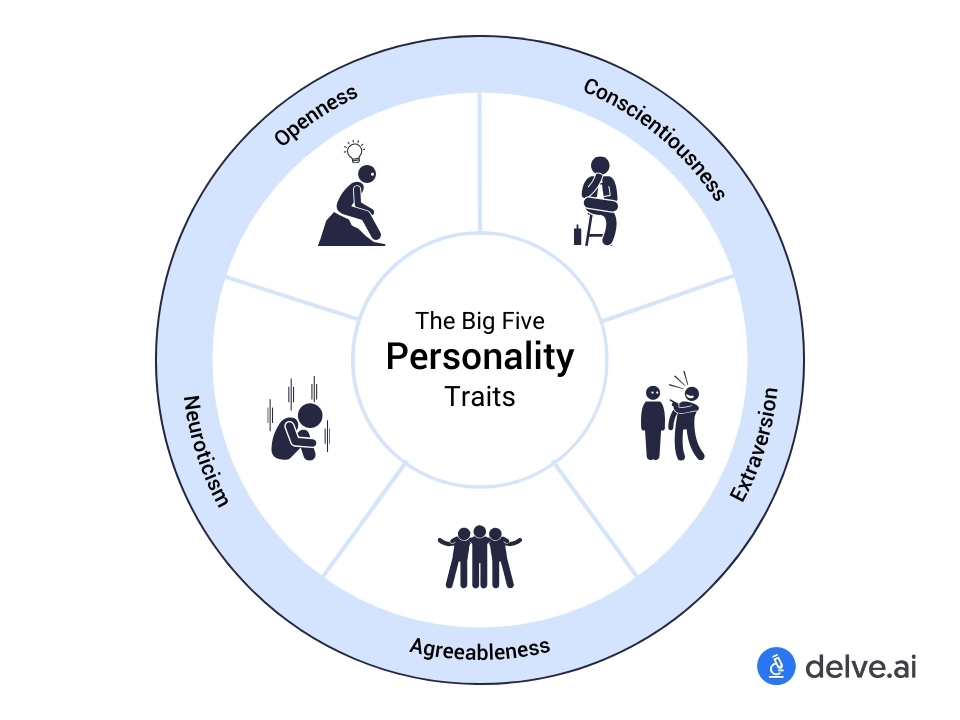
- Openness to experience: Those who score high on this factor are imaginative, curious, open to new ideas, and interested in cultural pursuits. In contrast, those who score low are rigid.
- Extraversion: It characterises people who are socially active, assertive, outgoing, talkative, and fun loving. On the opposite side are people who are shy.
- Agreeableness: This factor characterises people who are helpful, co-operative, friendly, caring, and nurturing. On the opposite are people who are hostile and self-centered.
- Neuroticism: People who score high on this factor are emotionally unstable, anxious, worried, fearful, distressed, irritable and hypertensive. On the opposite side are people who are well adjusted.
- Conscientiousness : Those who score high on this factor are achievement-oriented, dependable, responsible, prudent, hardworking and self-controlled. On the opposite are people who are impulsive
Difference Between Type and Trait Theory
| S.No | TYPE | TRAIT |
| 1. | Macro view | Micro View |
| 2. | Not Consistent | Consistent |
| 3. | On different type of personalities | Focus on human trait |
| 4. | Focuses on broad categories and generalizations. | Focuses Narrow categories (finer details of personality). |
| 5. | Stereotype(Imply that all individuals within a type share the same characteristics, ignoring individual variation.) | No stereotype(Recognize that people possess varying levels of multiple traits, allowing for uniqueness and complexity.) |
| 6. | Can be visualised from person’s behaviour | Can be visualised from person’s mind |
| 7. | Eg- Jung’s Typologyclassified persons into 2 types- introvert or extrovert. | Eg- Big 5 Factor Theory(e.g., openness, conscientiousness, extraversion, agreeableness, neuroticism) |
Determinants of Personality
Although there are a large number of factors which influence the development of personality, such factors have been broadly grouped into three categories given below.
- Biological factors: It emphasises that physique and body functioning are directly responsible for personality development. For eg. tall parents generally have tall children, The skin colour of parents also affects the skin colour of their children. If there is an increase or decrease in the level of hormones (secreted by Endocrine glands), then the person will suffer from different physical and mental deficiencies/problems which will influence one’s personality.
- Psychological factor: It includes Intellectual determinants, emotional determinants.
- Environment factor: These factors include the effect of the society in which a person lives, the atmosphere of the family to which one belongs, the financial conditions, and a person’s nurturing and upbringing etc. If the parents are too strict or too loving and protective, if they fulfil every demand of the child, then it will influence the child’s personality negatively.
These factors tend to develop personality in various ways called Determinants of personality.
Assessment of Personality
The efforts to understand the personality of a person through objective formal efforts is called personality assessment.
- Objectives of personality assessment:
- Clinical psychologists use personality tests to measure anxiety and personality disorders.
- Industrial psychologists use tests to select employees in the jobs.
- School counsellors use tests to understand the personality problems in children so that they can be helped.
- Refine clinical diagnoses in professional psychology.
- Increase the accuracy of behavioral prediction in a variety of contexts and settings.
- Improving oneself.
- In career selection and career counselling.
- In field like military settings to get specific personality traits for eg- SSB Interviews
[Following diagram can be followed for a chronological understanding about the assessment of personality. ]
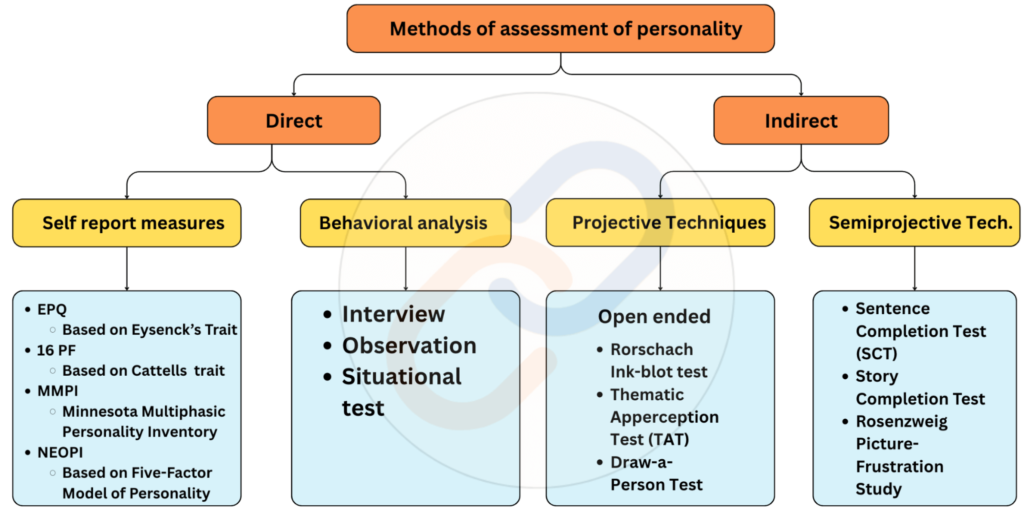
There are various measures to assess personality which can be broadly classified in 3 categories:
Self – Report Measures
In this method of personality assessment, direct questions are asked to the person about oneself to assess the personality. In this method, simple questions pertaining to personality attributes, are asked and the respondent is required to answer to either of the two or three options given as “Yes” or “No” or “Cannot say”.
There is no right or wrong answer and there is no time limit. These responses to the questions in the test are scored. Some examples of self report measures used as a personality test are as follows.
MMPI
- Known as Minnesota Multiphasic Personality Inventory.
- Developed by Hathaway and Mckinley.
- Effectively identifies different psychological disorders related to personality (Psychopathology).
- Person has to be endorsed as “true” or “false” or “cannot say”.
- It has 10 clinical scales and 3 validity scales.
- The revised version of this test is MMPI-2. It has 567 statements.
- On the same premise, Jodhpur Multiphasic Personality Inventory (Joshi & Malik, 1983) has been constructed in India, which makes assessment of psychoneurosis, psychosis, psychosomatic disorders, and validity indices.
EPQ
- Known as Eysenck Personality Questionnaire.
- Developed by Eysenck, evaluates two dimensions of personality i.e. introversion-extraversion and emotional stability-instability.
- Later a third dimension named psychoticism – sociability was added.
- A person who scores high on this dimension shows aggressiveness, hostility, lack of emotions, antisocial tendencies and egocentrism.
16 P.F
- Known as the Sixteen Personality Factor Questionnaire.
- This test was developed by Raymond Cattell.
- It is based on 16 types of source traits.
- This test is used on students of senior school level and adults (16 years or above). This test is useful in vocational guidance.
- Every situation requires to be answered either Agree/Disagree or neither agree nor disagree.
NEOPI
- Neuroticism, Extraversion, Openness Personality Inventory
- Developed by Costa & McCrae-1989
- Based on the Five-Factor Model of Personality (refer to the last section).
- It measures the five dimensions of personality which are considered to be the basic aspects of personality
Limitations:
- The responses given, could be as a result of high level of social desirability, or where the respondent tries to make an impression.
- The assessment can be distorted because of the acquiescence effect. It is a tendency of a person to answer in affirmative (yes) to the items in an inventory, regardless of the content of the item.
- The inventories can be administered to literate people only.
Projective techniques
In self-report measures, the person being assessed understands the questions asked. Psychologists have noticed that people sometimes hesitate to share personal emotions, thoughts, or motives and give answers to create a good self-image or gain social approval, making self-report measures less accurate. To solve this, projective techniques are used.
These techniques, based on Sigmund Freud’s psychoanalytic theory, help understand the unconscious mind, which direct methods like self-reports cannot reveal. Projective techniques rely on the projective hypothesis and are commonly used for deeper personality assessment.
Rorschach Ink-blot test :
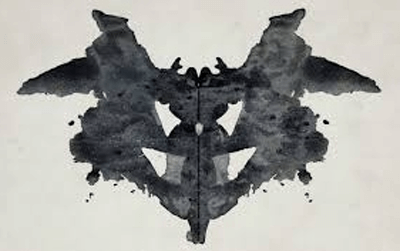
- This test was developed by Hermann Rorschach.
- It contains 10 cards depicting ink-blot pictures shown in specific order.
- Person is asked to show what they see in the ink blot and where they see it, what it reminds them of.
- Each inkblot is printed in the middle of a 7 x 10 sized card
- A detailed scoring procedure has been developed to score the responses given by the person.
- Rigorous training is necessary for administration of this test and interpretation of results.
Thematic Apperception Test (TAT)
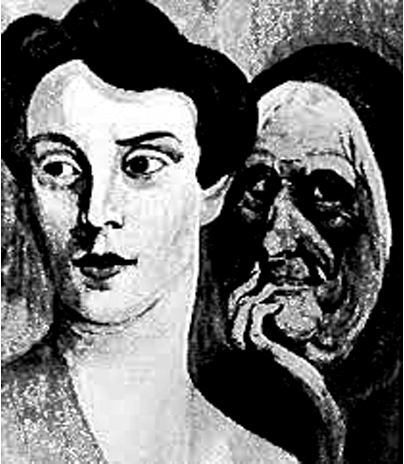
- This test was developed by Morgan and Murray.
- It consists of 30 cards on which black and white pictures are printed. One card is blank. Total 20 cards can be administered on a subject. Some pictures are printed on the cards (see figure).
- These cards are presented to the subject one by one. The subject is asked to write a story based on the pictures printed on the given card. The subject is also given some questions such as what is happening in this picture, what happened before this, what will happen after this, what the different characters presented in the picture are thinking or experiencing etc. The subject writes a story on the basis of answers to these questions. The subject’s motivation can be understood on the basis of the story.
- Eg- SSB Interviews of Indian Army.
Sentence Completion Test (SCT)
- In this test, many incomplete sentences are presented to the subject.
- The subject has to complete these sentences. Some sentences are given for example.
- My father……………………………..
- My biggest fear is………………..
- My life………………………………….
Word Association Test (WAT)
- Many words are shown back to back to the person.
- He/she is required to respond with the first thought that comes to mind.
Rosenweig’s picture frustration test (PFT)
- This test was developed by Rosenzweig to assess how people express aggression in the face of a frustrating situation.
- The test presents a series of situations in which one person frustrates another with the help of cartoon-like pictures.
- The subject is asked to tell what the other (frustrated) person will say or do.
- An attempt is made to examine whether the focus is on the frustrating object, or on protection of the frustrated person, or on constructive solution of the problem.
- Pareek has adapted this test for use with the Indian population. Draw-a-Person Test
- It is a simple test in which the subject is asked to draw a person on a sheet of paper.
- A pencil and eraser is provided to facilitate drawing. After the completion of the drawing, the subject is generally asked to draw the figure of an opposite sex person.
- Finally, the subject is asked to make a story about the person as if she/he was a character in a novel or play.
Behavioural Analysis
A person’s behaviour in different situations provides important information about the personality. Some of the behavioural analysis methods are interview, observation, situations tests etc.
- Interview
- In this method, the person whose personality is to be assessed is interviewed.
- Some specific questions and its responses provide necessary information to assess that person’s personality.
- Observation
- The term observations means to see. In this method, a trained person observes an individual’s behaviour, gestures, postures, body language to assess the personality.
- Situational tests
- A person is placed in some specific situations and his behaviour is studied.
- For eg- On your way to an examination, you witness an accident. What actions would you take?
- It helps in identifying various aspects of the personality whether the person is of extremely angry nature or has patience etc.
FAQ (Previous year questions)
Direct Techniques : It involves gathering information directly from individuals who are aware their personality is being assessed. These methods face the following issues
Socially Desirable Responses: People often present themselves in a socially acceptable way, skewing results. e.g., exaggerating kindness on a job application.
Self-Consciousness: People might give answers that sound good to others, not their real ones.
Acquiescence Bias: Some individuals agree with questionnaire items regardless of content, often saying “yes,” reducing response accuracy.
Limited Insight: Direct questions may not uncover deeper, unconscious personality traits or motivations, missing critical aspects of the individual’s personality.
Oversimplification: Predefined options (like Big Five traits) fail to capture the complexities and dynamics of personality.
Reduced Reliability: Social desirability and acquiescence in self-report measures, combined with self-consciousness, make these techniques less reliable.
Indirect Techniques : Indirect methods, like inkblot tests or story tasks, use unclear prompts to learn about personality. They have these issues:
Requirement for Specialized Skills: Interpreting responses requires advanced training and expertise. Without proper skills, results may be misinterpreted.
Subjectivity in Interpretation: Many projective tests, like the Rorschach, depends heavily on the assessor’s judgment, leading to inconsistencies and potential bias.
Reliability of Scoring: Different assessors may interpret the same response differently, reducing the reliability of projective test results.
Validity Concerns: Interpretations may not always accurately reflect the individual’s personality, as they depend on the assessor’s judgment, which can introduce bias.
Time-Consuming & Expensive: Tests like Rorschach or TAT demand detailed analysis, making them resource-intensive.
Friedman and Rosenman classified individuals into two personality types: Type A and Type B.
Type A: Characteristics: Individuals with Type A personality are highly motivated, lack patience, feel short of time, are in a great hurry and often feel overwhelmed with work. They struggle to relax and slow down.
Health Implications: Such individuals are more prone to hypertension and coronary heart disease (CHD). The risk of developing CHD in Type A individuals can sometimes surpass that associated with high blood pressure, elevated cholesterol levels, or smoking.
Type B: Characteristics: Type B personality is essentially the absence of Type A traits. These individuals are more relaxed, patient, and less driven by time constraints.
Note→ Now, Morris and More additionally have suggested Type C and Type D personalities respectively.
The Big Five personality traits, as identified by Paul Costa and Robert McCrae, are:
Openness to Experience: Imaginative, curious, open to new ideas, and interested in cultural pursuits.
Conscientiousness: Achievement-oriented, dependable, responsible, prudent, hardworking, and self-controlled.
Extraversion: Socially active, assertive, outgoing, talkative, and fun-loving.
Agreeableness: Helpful, cooperative, friendly, caring, and nurturing.
Neuroticism: Emotionally unstable, anxious, worried, fearful, distressed, irritable, and hypertensive.
Rorschach Ink-blot test (Hermann Rorschach): contains 10 cards depicting ink-blot pictures shown in specific order
Person is asked to show what they see in the ink blot and where they see it, what it reminds them of.
A detailed scoring procedure has been developed to score the responses given by the person.
Thematic Apperception Test (TAT)(Morgan and Murray): It consists of 30 cards on which black and white pictures are printed. One card is blank. Total 20 cards can be administered on a subject.
These cards are presented to the subject one by one. The subject is asked to write a story based on the pictures printed on the given card.
The subject is also given some questions such as what is happening in this picture, what happened before this, what will happen after this, what the different characters presented in the picture are thinking or experiencing etc.
The subject writes a story on the basis of answers to these questions. The subject’s motivation can be understood on the basis of the story.
Draw-a-Person Test: It is a simple test in which the subject is asked to draw a person on a sheet of paper. A pencil and eraser is provided to facilitate drawing. After the completion of the drawing, the subject is generally asked to draw the figure of an opposite sex person. Finally, the subject is asked to make a story about the person as if s/he was a character in a novel or play.
The idiographic approach to personality is a way of studying people that centers on the uniqueness of each individual. Instead of looking for broad rules or traits that apply to everyone , this method aims to explore a person’s specific qualities, life experiences, and personal growth.
It focuses on understanding the individual in a deep and detailed way, viewing them as a one-of-a-kind case rather than part of a general group.
Thema in TAT refers to the recurring motives, emotions, and conflicts found in the subject’s stories. These themes help psychologists understand the person’s personality and inner experiences.
Apperception is the process of understanding new situations by applying personal experience and emotions.When a person is given a picture with no clear meaning and asked to tell a story, they naturally draw from their own past, feelings, and beliefs. It helps psychologists understand how the person makes sense of the world.
Eros and Thanatos are the two driving forces of Id (part of personality which operates unconsciously) in A structural model of our personality by Sigmund Freud.
Eros was the God of love in Greek mythology. According to Freud, in the context of id, Eros is the life force. It is responsible for our life instinct and survival, which includes sexual desire, reproduction desire and pain avoidance.
The counterpart of Eros is Thanatos-the death force or instinct. It is responsible for violence, aggression and hate like negative feelings. The aim of Thanatos is to balance the drive of Eros by driving us towards death and destruction. When personality is dominated by id, then individuals tend to become more impulsive, such people will do what they want irrespective time, place and situation, just like a kid.
Introvert and Extrovert Personality –
Introverts – According to Jung’s Personality Theory, they do not like to mingle with people. They have very few friends. They are self-centered and conservative. Such people are dogmatic in the sense that they follow the traditions and customs of the society without ever giving thought to their justifiability.
Extroverts – Such people are socially oriented. They like to mix up with people, are fun loving, and optimistic. They are realistic in their approach towards life. Often such people exhibit leadership qualities.
Characteristics of Projective Technique of Personality Assessment
Projective techniques are based on Sigmund Freud’s psychoanalytic theory,
These are indirect methods used to understand someone’s personality, especially their unconscious thoughts and feelings.
These techniques are based on psychoanalytic ideas, which say that our behavior is also shaped by unconscious forces.
These techniques utilize unstructured or ambiguous stimuli to encourage the projection of internal motives and emotions.
Respondents are unaware of the test’s purpose and scoring criteria.
No responses are labelled as right or wrong; each response is seen as revealing meaningful aspects of personality.
Interpretation is subjective, time-consuming & requires expert training for scoring and analysis.
These tests are difficult to score objectively but are useful in uncovering deep-rooted personality traits.
Gordon Allport – “The dynamic organization within the individual of those psychophysical systems that determine his unique adjustments to the environment.”
Semi-projective techniques are personality assessment tools that combine elements of objective and projective tests, enabling access to both surface-level and deeper, unconscious traits of the individual.
Semi-projective techniques give some structure, like a sentence or a picture, allowing respondents to express themselves within defined yet flexible parameters. This balance makes interpretation easier than fully projective tests, but more revealing than objective ones.
They assess both the conscious responses and the unconscious impulses behind them, offering a holistic understanding of personality.
These techniques are instrumental in uncovering unconscious elements of personality, including internal motivations, underlying fears, and deep-seated anxieties.
Due to the indirect nature of semi-projective stimuli, respondents are less inclined to tailor their responses for social approval, thus enhancing the authenticity of the assessment.
